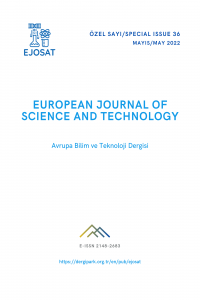Abstract
Şehirleşmenin artmasıyla birlikte şehirlerde biriken çöpler büyük bir sorun haline geldi. Birikmiş çöplerin tamamı gereksiz olarak sınıflandırılırken, günümüzde geri dönüşüm teknolojilerinin gelişmesiyle birlikte çöpün içindeki malzemelerin çoğu geri dönüştürülebilir olarak kabul edilmektedir. Geri dönüştürülebilir malzemelerin günlük hayatımızda geri dönüşümü hem malzeme gelişimi için hem de ekolojik anlamda dünyadaki varoluşun yaşam döngüsünü oluşturmak için elzemdir. Geri dönüştürülebilir malzemeleri çöpten ayırmak için hemen her ülkede farklı çalışmalar yapılmaktadır. Geri dönüştürülebilir malzemeleri yapay zeka ile otomatik olarak tespit edebilmek, maliyet, insan kaynağı ve zamandan fayda sağlayacaktır. Bu ayrıştırma konusu literatürde yeni bir çalışma alanı olarak karşımıza çıkmaktadır. Bu çalışma, transfer öğrenme yöntemini kullanarak çöpleri otomatik olarak sınıflandırmayı amaçlamaktadır. Farklı transfer öğrenme yöntemleri kullanılan bu çalışmada, Resnet50-V2 modelinin sonuçlarda %97,07 gibi yüksek bir başarı oranı gösterdiği görülmüştür.
References
- M.V. Rao, K.N.V.R. Sekhar, B. Jayanth and K. Santosh.” An Automatic Garbage Classification System” in 2021 JETIR, 2021, vol. 8, pp.4-9.
- H. Wang, "Garbage Recognition and Classification System Based on Convolutional Neural Network VGG16," 2020 3rd International Conference on Advanced Electronic Materials, Computers and Software Engineering (AEMCSE), 2020, pp. 252-255, doi: 10.1109/AEMCSE50948.2020.00061.
- S. L. Rabano, M. K. Cabatuan, E. Sybingco, E. P. Dadios and E. J. Calilung, "Common Garbage Classification Using MobileNet," 2018 IEEE 10th International Conference on Humanoid, Nanotechnology, Information Technology,Communication and Control, Environment and Management (HNICEM), 2018, pp. 1-4, doi: 10.1109/HNICEM.2018.8666300.
- Dataset website. [Online]. Available: https://www.kaggle.com/datasets/asdasdasasdas/garbage-classification
- H. H. Mohammed, S. Sürücü and R. Choupani, "Lung Inflammatory Classification of Diseases using X-ray Images," 2021 6th International Conference on Computer Science and Engineering (UBMK), 2021, pp. 548-553, doi: 10.1109/UBMK52708.2021.9558905.
- E. Kiliç, İ. N. Ecemiş and H. O. İlhan, "Narenciye Ağaç Yaprak Hastalıklarının Evrişimli Sinir Ağları ile Sınıflandırılması," 2021 5th International Symposium on Multidisciplinary Studies and Innovative Technologies (ISMSIT), 2021, pp. 452-456, doi: 10.1109/ISMSIT52890.2021.9604631.
- M. Tan and Q. V. Le. “EfficientNet: Rethinking Model Scaling for Convolutional Neural Networks.” ArXiv abs/1905.11946 (2019): n. pag.
- C. Szegedy, V. Vanhoucke, S. Ioffe, J. Shlens and Z. Wojna, "Rethinking the Inception Architecture for Computer Vision," 2016 IEEE Conference on Computer Vision and Pattern Recognition (CVPR), 2016, pp. 2818-2826, doi: 10.1109/CVPR.2016.308.
- Z. Barret, V. Vasudevan, J. Shlens and Q. V. Le. “Learning Transferable Architectures for Scalable Image Recognition.” 2018 IEEE/CVF Conference on Computer Vision and Pattern Recognition (2018): 8697-8710.
- H. Kaiming, X. Zhang, S. Ren and J. Sun. “Deep Residual Learning for Image Recognition.” 2016 IEEE Conference on Computer Vision and Pattern Recognition (CVPR) (2016): 770-778.
- J. Cohen. “A Coefficient of Agreement for Nominal Scales.” Educational and Psychological Measurement 20, no. 1 (April 1960): 37–46. https://doi.org/10.1177/001316446002000104.
Abstract
With the increase of urbanization, the garbage accumulated in the cities has become a big problem. While all of the accumulated garbage is classified as unnecessary, today, with the development of recycling technologies, most of the materials in the garbage are considered recyclable. Recycling recyclable materials in our daily lives is essential both for material development and for creating the life cycle of existence in the world in ecological terms. Different studies are carried out in almost every country to separate recyclable materials from the garbage. Being able to detect recyclable materials automatically with artificial intelligence will benefit from cost, human resources and time. This decomposition issue appears as a new field of study in the literature. This study aims to classify garbage by automatically using the transfer learning method. By using different transfer learning methods, it was seen that the Resnet50-V2 model showed a high success rate of 97.07% in the results.
References
- M.V. Rao, K.N.V.R. Sekhar, B. Jayanth and K. Santosh.” An Automatic Garbage Classification System” in 2021 JETIR, 2021, vol. 8, pp.4-9.
- H. Wang, "Garbage Recognition and Classification System Based on Convolutional Neural Network VGG16," 2020 3rd International Conference on Advanced Electronic Materials, Computers and Software Engineering (AEMCSE), 2020, pp. 252-255, doi: 10.1109/AEMCSE50948.2020.00061.
- S. L. Rabano, M. K. Cabatuan, E. Sybingco, E. P. Dadios and E. J. Calilung, "Common Garbage Classification Using MobileNet," 2018 IEEE 10th International Conference on Humanoid, Nanotechnology, Information Technology,Communication and Control, Environment and Management (HNICEM), 2018, pp. 1-4, doi: 10.1109/HNICEM.2018.8666300.
- Dataset website. [Online]. Available: https://www.kaggle.com/datasets/asdasdasasdas/garbage-classification
- H. H. Mohammed, S. Sürücü and R. Choupani, "Lung Inflammatory Classification of Diseases using X-ray Images," 2021 6th International Conference on Computer Science and Engineering (UBMK), 2021, pp. 548-553, doi: 10.1109/UBMK52708.2021.9558905.
- E. Kiliç, İ. N. Ecemiş and H. O. İlhan, "Narenciye Ağaç Yaprak Hastalıklarının Evrişimli Sinir Ağları ile Sınıflandırılması," 2021 5th International Symposium on Multidisciplinary Studies and Innovative Technologies (ISMSIT), 2021, pp. 452-456, doi: 10.1109/ISMSIT52890.2021.9604631.
- M. Tan and Q. V. Le. “EfficientNet: Rethinking Model Scaling for Convolutional Neural Networks.” ArXiv abs/1905.11946 (2019): n. pag.
- C. Szegedy, V. Vanhoucke, S. Ioffe, J. Shlens and Z. Wojna, "Rethinking the Inception Architecture for Computer Vision," 2016 IEEE Conference on Computer Vision and Pattern Recognition (CVPR), 2016, pp. 2818-2826, doi: 10.1109/CVPR.2016.308.
- Z. Barret, V. Vasudevan, J. Shlens and Q. V. Le. “Learning Transferable Architectures for Scalable Image Recognition.” 2018 IEEE/CVF Conference on Computer Vision and Pattern Recognition (2018): 8697-8710.
- H. Kaiming, X. Zhang, S. Ren and J. Sun. “Deep Residual Learning for Image Recognition.” 2016 IEEE Conference on Computer Vision and Pattern Recognition (CVPR) (2016): 770-778.
- J. Cohen. “A Coefficient of Agreement for Nominal Scales.” Educational and Psychological Measurement 20, no. 1 (April 1960): 37–46. https://doi.org/10.1177/001316446002000104.
Details
| Primary Language | English |
|---|---|
| Subjects | Engineering |
| Journal Section | Articles |
| Authors | |
| Early Pub Date | April 11, 2022 |
| Publication Date | May 31, 2022 |
| Published in Issue | Year 2022 Issue: 36 |


